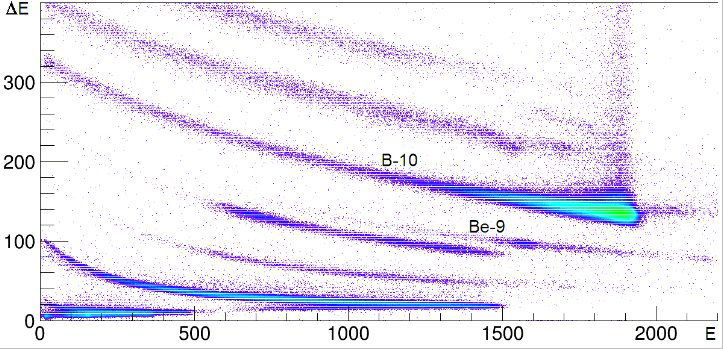Speaker
Description
In this work the measurements of the differential cross sections (DCS) of the reaction 16O(10B,9Be)17F have been carried out at 10B ions beam of the C-200P cyclotron of the Heavy Ion Laboratory (University of Warsaw) with the energy E10B=41.3 MeV. The purpose of the experiment is to find out the suitability of this reaction near the Coulomb barrier to extract the ANC values to use in the calculations of astrophysical S- factors of proton radiative capture.
Thin Al2O3 self-supporting film with the thickness of ~0.15 mg/cm2 was used as a target. The charged particles were detected and identified by four ΔЕ-Е counter telescopes which were installed in the ICARE experimental chamber 1. The spectra were analyzed with the use of ROOT 2 software. A typical two–dimensional spectrum (ΔE, E) is shown in Fig. 1.


The analysis of the 16O(10B,9Beg.s.)17Fg.s. reaction by testing function R(b) of MDWBA approach [3] shows that the proton transfer has peripheral character at the forward hemisphere of the 9Be escape as the function R(b) is practically constant at varying the values of geometry parameters of the Woods-Saxon potential within the physically reasonable range (see Fig. 2). So the DCS of the reaction should be calibrated by the product of the ANCs squares (C10B→9Be+p)2×(C17F→16O+p)2 in accordance with MDWBA. As the ANC value C10B→9Be+p is rather well known from [4,5], one can obtain the ANC for the 17F→16O+p.
- M. Rousseau et al. // Phys.Rev. C66, 034612 (2002).
- ROOT, A Data Analysis Framework, http://root.cern.ch/drupal/.
- Tojiboev O. R., et al. //Phys.Rev. C94, 054616 2016.
- Mukhamedzhanov A.M., Clark H.L., Gagliardi C.A., et al. // Phys.Rev. C56, №3. –1997, 1302.
- S.V. Artemov, I.R. Gulamov, E.A. Zaparov, et al. // Phys. At. Nucl. V. 59 № 3 (1996), 428.